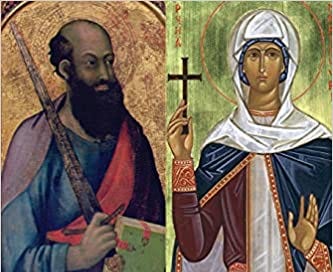Man and Woman, One in Christ: An Exegetical and Theological Study of Paul’s Letters (Part 10)
This post concludes Man and Woman, One in Christ: An Exegetical and Theological Study of Paul’s Letters.
In reading the last two chapters, I was reminded of my post “Interpreting the Bible, Nursery Rhymes, or Just About Anything Else” and the importance of not importing our traditions and biases into God’s Word. What struck me right out of the gate was Payne’s assertion that
“If it were Paul’s intention that women should forever be excluded from teaching and from positions of authority in the church, there is no more natural place in all his letters for him to have said so than in the…passage listing requirements for overseers and deacons, 1 Tim 3:1-12. Unfortunately, practically all English versions of 1 Tim 3:1-13 and Titus 1:5-9 give the false impression that Paul uses masculine pronouns, implying that these church leaders must be male. In Greek, however, there is not even one masculine pronoun or ‘men only’ requirement for the offices of overseer and deacon in 1 Tim 3:1-12 or elder in Tit 1:5-9.”
This raises serious questions as to why translators of every popular English translation (e.g., NIV, ESV, NASB, RSV, NRSV, and even the TNIV) would translate these passages this way. While Payne does not demonstrate what was driving translators’ mindset on why these passages are not more faithful to the original language, one has to wonder if gender bias was not a motivation. Even if 1 Tim 2:12provides a “limitation into the requirements for overseer,” it does not warrant the vast number of masculine pronouns introduced into the text, especially those “formally equivalent” translations such as the ESV, NASB, et al. (see Payne, p. 24, note 1 for the number of masculine pronouns inserted per English translation).
By providing a probability analysis of the words and expressions used of women in 1 Timothy vis-a-vis the descriptions of elder or deacon, Payne shows that “these qualifications not only can, but in fact do, apply to women.” Special attention is given to “one woman man” and Payne opines this applies not to divorced men or women per se, but to those who may be in polygamous relationships or who are sexually unfaithful to their spouse. Although no evidence is offered that polygamy was a concern in Ephesus (data regarding polygamous practices in first century Ephesus is dubious), Paul clearly insists on the moral requirement of fidelity to the marriage covenant, which women no less than men must demonstrate.
Whether Paul was addressing qualifications of deacons’ wives or female deacons, Payne astutely observes “if the only women who can serve are deacons’ wives, this requirement would disqualify all single women, all women whose husbands are not deacons, and all otherwise qualified men whose wives do not qualify.” And, he asks why the wives of overseers are overlooked yet qualifications for deacons’ wives are listed. Furthermore, no less than “sixty-one inscriptions and forty literary references to female deacons through the sixth century AD in the East, where the church in Ephesus was located” can be identified.
Thus, women can and should be eligible for the office of overseer and of deacon.
Conclusion with additional references
If 1 Cor 14:34-35 is an interpolation, then only one passage in the New Testament ( 1 Tim 2:12) restricts what women may do in the church. This restriction, according to Payne’s findings, favors a “present over a universal prohibition.” As I understand, this specific application to Ephesus would apply only in churches today where women were “assuming for themselves authority over men that the church had not granted them.” Paul neither prohibits women from teaching men nor from delegated authority, but does prevent women from doing what the false teachers had done, namely, assume a position of authority to teach others false doctrine.
I’ve chosen to make this series primarily a summary on each chapter since I do not believe I am qualified to offer a critical review. As I’ve said before, Payne’s book is a must read for anyone who takes seriously God’s Word and wrestles with the issues it raises. While years may pass before the scholastic landscape integrates and appropriates this magisterial book, I’m confident that this will become a standard reference. Equally important, every local church must take seriously Payne’s findings and evaluate its position in light of this research. If, at the end, no changes are made to male-only leadership roles, the church will at least be better informed.
Additional references include:
Craig Blomberg’s review in the Denver Journal. See also the extensive response by Payne at page bottom.
Dr. Alan Myatt‘s paper read at the 2009 annual meeting of the Evangelical Theological Society: On The Compatibility of Ontological Equality, Hierarchy and Functional Distinctions
Ben Witherington’s “Why Arguments against Women in Ministry Aren’t Biblical“
James Choung: Can Women Teach? An exegesis of 1 Timothy 2:11-15 and 1 Corinthians 14:33-40
Share (please & thank you)




